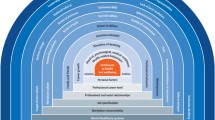Key Points
-
This paper reports a survey of dental hygienist numbers in Canada, Japan, the USA and Western Europe.
-
The results indicate that although the combined populations of Canada, Japan and the USA and the total number of dentists working in these three countries are broadly similar to those in the 18 member states of the European Economic Area (EEA), there are over 15 times as many dental hygienists in the three countries than in the EEA.
-
Fewer than 10,000 dental hygienists worked in EEA member states other than the UK.
-
The potential for the UK to recruit large numbers of hygienists from the EEA is therefore extremely poor.
Abstract
Objective The aims of this study were to establish how many dental hygienists were licensed to practice in Canada, Japan, USA and the 18 member states of the European Economic Area (EEA) and to compare these with the populations and numbers of dentists practising in the countries concerned.
Method Data for the overall populations, numbers of 'active' dentists, of dental hygienists and of employed dental hygienists in the member states of the EEA in 1998 were taken from the responses to a Council of European Chief Dental Officers survey carried out in 2000/2001. Data for these variables for Canada, Japan and the USA in 1998 were accessed from published reports. The ratios of population: active dentist; population: dental hygienist; and active dentist: dental hygienist were calculated and compared.
Results The overall populations and total number of active dentists in the 18 EEA member states and Canada plus Japan plus the USA were broadly similar in 1998 (EEA overall population 381 million with 245,169 active dentists: Canada/Japan/USA overall population 421 million with 253,825 active dentists). However, there were only 13,295 dental hygienists in the EEA as opposed to a total of 215,435 in Canada, Japan and the USA. In terms of population:dental hygienist and active dentist: dental hygienist ratios the UK was found to have proportionally far fewer dental hygienists than Canada, Japan, USA or the four Nordic members of the EEA.
Conclusion The survey revealed that relative to overall populations and numbers of dentists, there are far fewer dental hygienists in the EEA than in Canada, Japan and the USA and that scope for the UK to import dental hygienists from other EEA member states is probably very limited.
Similar content being viewed by others
Log in or create a free account to read this content
Gain free access to this article, as well as selected content from this journal and more on nature.com
or
References
Scottish Executive Health Department. Workforce planning for dentistry in Scotland – a strategic review. Interim report and recommendations. Edinburgh: The Stationery Office, 2000.
Department of Health. NHS Dentistry: Options for Change. London: Department of Health, 2002.
Widström E, Eaton KA, Borutta A . Dybizbánska E, Broukal Z . Oral healthcare in transition in Eastern Europe. Br Dent J 2001; 190: 580–584.
Eaton KA . Factors affecting community oral health care needs and provision. PhD thesis, London: University of London, 2002.
Zillén PÅ, Mindak M . World dental demographics. Int Dent J 2000; 50: 194–197.
Japanese Ministry of Health, Labour and Welfare. Statistics and Information Department Annual Report, 1999. Tokyo: Ministry of Health, Labour and Welfare.
American Dental Association Survey Center. The 1998 survey of dental practice, characteristics of dentists in private practice and their patients 2000. Chicago: American Dental Association.
Eurostat. Statistics on health staff in the European Union 2000. Brussels: European Commission.
Sheiham A . Planning for manpower requirements in dental public health. In Slack G L, Burt B A. Eds. Dental public health: an introduction to community dental health. Bristol: John Wright and Sons, 1981. Chapter 8, pp148–200.
Seward MH . Better opportunities for women dentists – a review of the contribution of women dentists to the workforce, 2001. London: Department of Health.
Hillam DG . Career patterns of dental hygienists qualifying from the Liverpool Dental Hospital School of Dental Hygiene. Br Dent J 1989; 166: 310–311.
Callis PD, Wohlegemuth BG . Career patterns of dental hygienists in Scotland. Br Dent J 2000; 189: 32–34.
Gibbons DE, Corrigan M, Newton JT . A national survey of dental hygienists: working patterns and job satisfaction. Br Dent J 2001; 190: 207–210.
Acknowledgements
The authors wish to thank the members of the Council of European Chief Dental Officers for gathering and reporting the data for EEA member states quoted in this paper and Mr David Gort for his help in preparing the figure.
Author information
Authors and Affiliations
Corresponding author
Additional information
Refereed Paper
Rights and permissions
About this article
Cite this article
Eaton, K., Newman, H. & Widström, E. A survey of dental hygienist numbers in Canada, the European Economic area, Japan and the United States of America in 1998. Br Dent J 195, 595–598 (2003). https://doi.org/10.1038/sj.bdj.4810736
Received:
Accepted:
Published:
Issue date:
DOI: https://doi.org/10.1038/sj.bdj.4810736
This article is cited by
-
Developing a reliable and valid competency model for assistant dentists in China
BMC Medical Education (2021)
-
The decline in dental caries among Korean children aged 8 and 12 years from 2000 to 2012 focusing SiC Index and DMFT
BMC Oral Health (2016)
-
Will we have enough hygienists?
British Dental Journal (2003)


